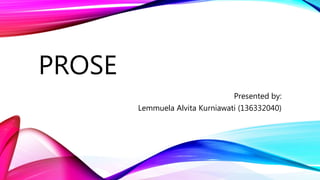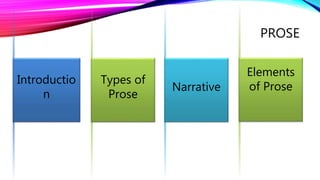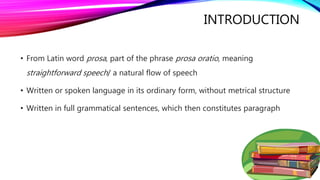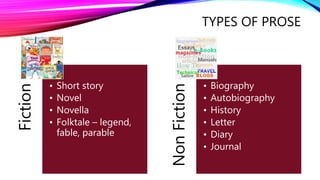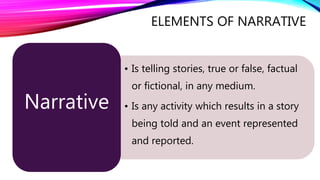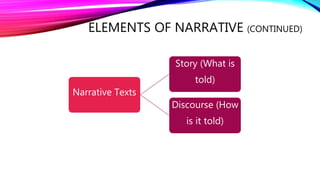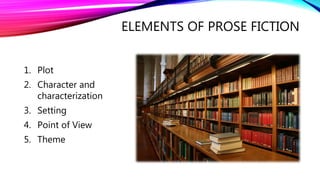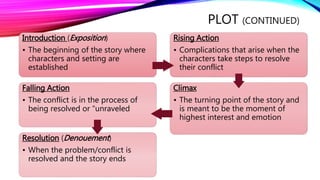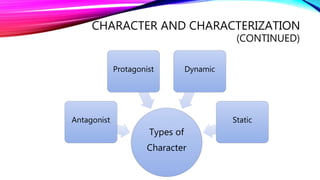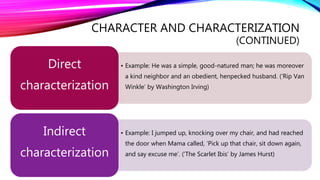Prose
- 1. PROSE Presented by: Lemmuela Alvita Kurniawati (136332040)
- 2. PROSE Introductio n Types of Prose Narrative Elements of Prose
- 3. INTRODUCTION • From Latin word prosa, part of the phrase prosa oratio , meaning straightforward speech/ a natural flow of speech • Written or spoken language in its ordinary form, without metrical structure • Written in full grammatical sentences, which then constitutes paragraph
- 4. TYPES OF PROSE Fiction • Short story • Novel • Novella • Folktale – legend, fable, parable Non Fiction • Biography • Autobiography • History • Letter • Diary • Journal
- 5. • Is telling stories, true or false, factual or fictional, in any medium. • Is any activity which results in a story being told and an event represented and reported. Narrative ELEMENTS OF NARRATIVE
- 6. ELEMENTS OF NARRATIVE (CONTINUED) Narrative Texts Story (What is told) Discourse (How is it told)
- 7. ELEMENTS OF PROSE FICTION 1. Plot 2. Character and characterization 3. Setting 4. Point of View 5. Theme
- 8. PLOT The structure, “framework” or “skeleton” of the story The story arc that holds all the events of a story in an orderly way (E.M. Froster) The casual and logical structure that connects events (E.M. Froster)
- 10. PLOT (CONTINUED) Introduction (Exposition) • The beginning of the story where characters and setting are established Rising Action • Complications that arise when the characters take steps to resolve their conflict Climax • The turning point of the story and is meant to be the moment of highest interest and emotion Falling Action • The conflict is in the process of being resolved or “unraveled Resolution (Denouement ) • When the problem/conflict is resolved and the story ends
- 11. CHARACTER AND CHARACTERIZATION • Character : a person or being in a story that performs the action of the plot. • Characterization : the process by which the writer reveals the personality of the character
- 12. CHARACTER AND CHARACTERIZATION (CONTINUED) Types of Character Antagonist Protagonist Dynamic Static
- 13. CHARACTER AND CHARACTERIZATION • Example: He was a simple, good-natured man; he was moreover a kind neighbor and an obedient, henpecked husband. (‘Rip Van Winkle’ by Washington Irving) Direct characterization • Example: I jumped up, knocking over my chair, and had reached the door when Mama called, ‘Pick up that chair, sit down again, and say excuse me’. (‘The Scarlet Ibis’ by James Hurst) Indirect characterization (CONTINUED)
- 14. SETTING The historical time and place, and the social circumstances in the ‘world’ of the literature Geographic location • topography Cultural backdrop • way of life Artificial environment • buildings Properties • furniture
- 15. SETTING Like as he is to look at, so is his apartment in the dusk of the present afternoon. Rusty, out of date, withdrawing from attention, able to afford it. Heavy broad-backed old-fashioned mahogany and horsehair chairs, not easily lifted, obsolete tables with spindle-legs and dusty baize covers, presentation prints of the holders of great titles in the last generation, or the last but one, environ him. A thick and dingy Turkey-carpet muffles the floor where he sits, attended by two candles in old-fashioned silver candlesticks, that give a very insufficient light to his large room. (Dickens, Bleak House, ch. 10).
- 16. POINT OF VIEW Point of view is how an author tells his or her reader about a character. • Involving the use of either of the two pronouns “I” and “we First person • Employing the pronoun “you” Second person • Entering the thought of every character Third person omniscient • Entering the thought of one character Third person limited
- 17. “I have of late,—but wherefore I know not,— lost all my mirth, forgone all custom of exercises; and indeed, it goes so heavily with my disposition that this goodly frame, the earth, seems to me a sterile promontory.” ‘Hamlet’ by Shakespeare POINT OF VIEW Harry had taken up his place at wizard school, where he and his scar were famous ...but now the school year was over, and he was back with the Dursleys for the summer, back to being treated like a dog that had rolled in something smelly. Harry Potter and the Chamber of Secrets by J.K. Rowling
- 18. THEME • A main idea or an underlying meaning of a literary work that may be stated directly or indirectly. • Examples of themes: Love and friendship War Crime and mystery Revenge
- 19. THANK YOU
Editor's Notes
- #4: Prose is a form of language which applies ordinary grammatical structure and natural flow of speech rather than rhythmic structure. Metrical structure includes meter, tempo, and rhythm Prose is the ordinary form of spoken and written language whose unit is the sentence, rather than the line as it is in poetry.
- #5: Novel is long narrative which includes fictional characters and events. Novella is a fictional prose which is longer than short story but shorter than novel (The strange case of Dr Jeckyll and Mr Hyde, the old man and the sea by Ernest Hemmingway) Folktale a tale/ legend passed on traditionally, especially one considered to be false or based on superstition. Fable is a brief story which provides a moral lesson at the end. Fable is described through plants, animals or natural objects by giving them human attributes. Parable provides moral lesson at the end of the story. It differs from fable in the characters. Parable has human characters. It can be found in religious texts such as the Bible or the Buddhist Tipitaka.s Non fiction is called informational materials. It provides information that is factual. Nothing is make-believe in this type of materials. Biography is a true account of people’s life which is written, composed, or produced by another person. The biography of a person written by that person History is a chronological report of past events and developments. Fiction is partly of totally imaginative. However, authors can also include factual information in a made-up story. Some types of fiction are historical fiction (the story takes the readers back to a certain period of time where they learn the daily life of a person or certain group of persons. The characters may interact with the actual historical characters but usually the main character is not based on the real person), realistic fiction (the story presents a problem of somebody’s life. It may cover such topics as family situations, cultural differences, or peer relationships), science fiction (type of modern fantasy. It explores scientific facts,. The author focuses on the adventure of exploring the wonder of discovering new world and people), mystery, romance, metafiction, short story
- #7: Theorists of narrative have long been in agreement that there are at least two levels in a narrative text: Something happens (What is told?) and this something is related in a certain way (How is it told?). Story consists of events (things that happen in the story) and existent (characters and setting to whom and where things happen) Discourse consists of some elements, some of them are plot, language (diction and syntax), and focalization (the perspective in which the story is told)
- #10: Gustav Freytag was a Nineteenth Century German novelist who saw common patterns in the plots of stories and novels and developed a diagram to analyze them in 1863.
- #13: Protagonist is the main character in a story Antagonist is the character or force that comes into conflict with the protagonist Dynamic : the character that changes as the story progresses i.e. Bilbo Baggins – The Hobbit – From hobbit homebody to adventurous brave hero. Static : character that do not change as the story develops i.e. Sherlock Holmes – The Complete Sherlock Holmes - confidence, quirky, neurotic brilliant detective.
- #14: How an author tells the readers about a character in a direct, straightforward manner The process by which the writer shows the character's personality through his/her speech, actions and appearance The narrator is a clumsy person who doesn’t have respect to his mother. His mother firmly tells him what to do, asserting her authority over him by being direct.
- #15: Setting can function as a means of characterization
- #16: Setting can function as a means of characterization This excerpt describes Mr Tulkinghorn’s room. Like his room (the narrator points this out), Mr Tulkinghorn is extremely secretive (dark, muffled, retired, locked), nobody knows how much he knows, he is closely associated with members of the nobility (“holders of great titles”) and he knows their secrets past and present. Tulkinghorn does not arouse much sympathy in the reader mainly because he is not accessible to any emotional appeal. His room also expresses this immovability: It is out-of date, "rusty" and "dusty", "not easily lifted", all epithets which suggest that there has not been any movement for some time.
- #18: Hamlet – 1 Harry Potter – 3 limited
- #19: Love and friendship are frequently occurring themes in literature. They generate emotional twists and turns in a narrative and can lead to a variety of endings: happy, sad or bittersweet. The theme of war has been explored in literature since ancient times. The literary woks utilizing this theme may either glorify or criticize the idea of war. Crime and mystery are utilized in detective novels. Such narratives also include sub-themes such as “crimes cannot be hidden”, “evil is always punished” etc. Revenge is another recurrent theme found in many popular literary works. A character comes across certain circumstances that make him aware of his need for revenge.
